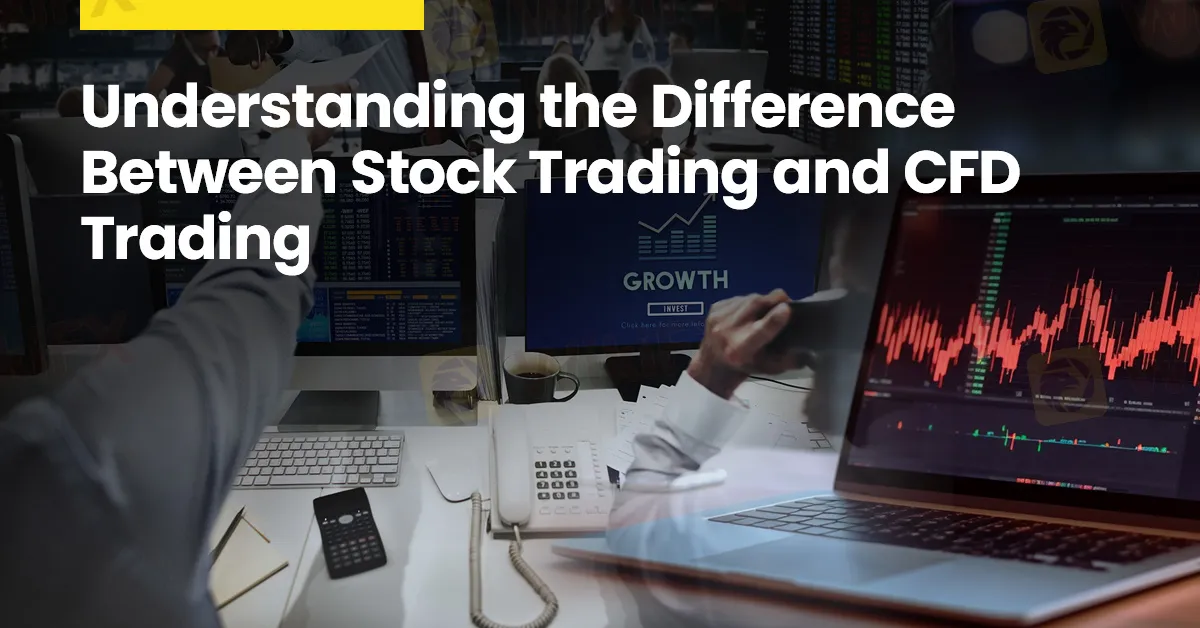简体中文
繁體中文
English
Pусский
日本語
ภาษาไทย
Tiếng Việt
Bahasa Indonesia
Español
हिन्दी
Filippiiniläinen
Français
Deutsch
Português
Türkçe
한국어
العربية
Understanding the Difference Between Stock Trading and CFD Trading
Abstract:In the dynamic world of online trading, two popular methods have emerged as favourites among traders: stock trading and trading Contracts for Difference (CFDs). This article will explain the differences between these two trading methods thoroughly.

In the dynamic world of online trading, two popular methods have emerged as favourites among traders: stock trading and trading Contracts for Difference (CFDs). While both offer opportunities to profit from market movements, they differ significantly in mechanics, risks, and potential rewards. Understanding these differences is crucial for any trader looking to navigate the financial markets effectively.

Stock trading involves buying and selling shares of publicly listed companies. When you purchase a stock, you own a portion of the company, entitling you to a share of its profits and voting rights at shareholder meetings. For instance, if you buy shares of Apple Inc., you become a partial owner of the tech giant and can benefit from its growth and dividends.
Stock trading offers several advantages, including ownership and dividends, as owning stocks means holding a stake in a company, with many companies paying dividends that provide a steady income stream. It also offers long-term growth potential, as stocks can appreciate significantly over time, and benefits from regulation and transparency, ensuring a high degree of investor protection. However, stock trading also has its drawbacks: it requires substantial capital, especially for high-priced shares, is limited to market hours which can restrict trading flexibility, and realizing significant returns can take a long time, depending on market and economic conditions.

CFDs, or Contracts for Difference, allow traders to speculate on the price movements of various financial instruments without owning the underlying asset. A CFD is a derivative product where you agree to exchange the difference in the asset's price from the moment you open the contract to when you close it. For example, if you believe Teslas stock price will rise, you can buy a CFD on Tesla shares. If the price goes up, you profit from the difference; if it falls, you incur a loss.
CFD trading offers several advantages, including leverage, which allows traders to control a large position with a relatively small amount of capital, thereby amplifying potential returns. It also provides market access, enabling traders to access a wide range of markets, including stocks, commodities, forex, and indices, from a single platform, and flexibility, as CFDs can be traded around the clock, offering greater flexibility compared to traditional stock markets. However, CFD trading also has its drawbacks: it involves high risk, as leverage can amplify losses and traders can lose more than their initial investment, there is no ownership of the underlying asset, meaning traders do not benefit from dividends or ownership rights, and it often comes with higher fees and spreads, which can eat into profits.

Imagine you have $1,000 to invest. In stock trading, you decide to buy shares of Microsoft at $250 per share. You can buy four shares. If Microsofts stock price increases by 10% to $275, your investment is now worth $1,100, giving you a $100 profit.
In contrast, with CFD trading, you could use leverage (e.g., 10:1) to control a $10,000 position in Microsoft with your $1,000. If Microsofts stock price rises by 10%, the value of your position increases to $11,000, netting you a $1,000 profit. However, if the price drops by 10%, you lose $1,000, potentially wiping out your entire investment.
In summary, both stock trading and CFD trading offer unique advantages and risks. Stock trading is ideal for those seeking ownership and long-term growth, while CFD trading appeals to those looking for flexibility and the potential for higher returns through leverage. Understanding these differences and carefully considering your risk tolerance and investment goals is essential to making informed trading decisions in todays financial markets.

Disclaimer:
The views in this article only represent the author's personal views, and do not constitute investment advice on this platform. This platform does not guarantee the accuracy, completeness and timeliness of the information in the article, and will not be liable for any loss caused by the use of or reliance on the information in the article.
Read more

Investing Capital in Focus as Complaints on Withdrawal and Other Issues Mount
Explore this guide we have exposed Investing Capital, which has mounted concerns for traders by disallowing withdrawals and making them lose their hard-earned money.

4 Warning Signs That Indicate You May Get Scammed in Your Forex Investments
In this blog, we will share with you a guide telling you about the tactics fraudsters employ to dupe investors.

Global Brokers Vs. Indian Rules: Why They Struggle in India
RBI issued a warning last year against 75 forex brokers. Those brokers are globally popular and regulated in other countries, but they are banned in India. Only few brokers even have physical offices located in India. So, why do global brokers face so many challenges in entering the Indian market?

Aetos: A Closer Look at Its Licenses
With multiple regulatory entries and one license now revoked, Aetos stands as a broker requiring closer scrutiny from investors, particularly those prioritizing license scope and jurisdictional compliance.
WikiFX Broker
Latest News
Tokenized Stocks: Innovation or Just Another Wrapper?
Gold Rush Again: What's Driving the Bullion Market Crazy Ahead of US Jobs Data?
XTB Launches Tax-Advantaged Retirement Accounts in Poland
Zaffex Broker Review
ECB Ends Easing Cycle, But The Eurozone Crisis Is Just Beginning
Amazon deploys its 1 millionth robot in a sign of more job automation
MT4 and MT5 Platforms - Helping Traders Up Their Forex Trading Game
A bare-bones deal is Europe's best hope in trade talks with the U.S., sources say
10-year Treasury yield remains higher despite weak ADP jobs report
Blueberry Markets Revamps its Website
Currency Calculator


